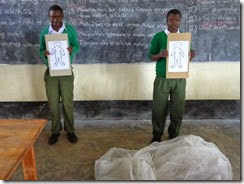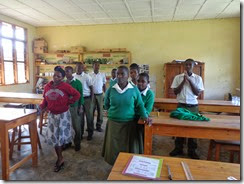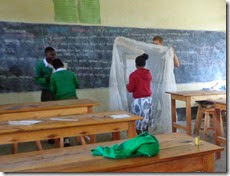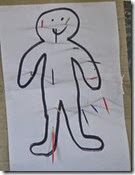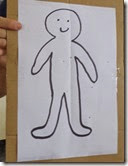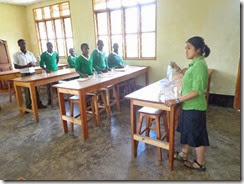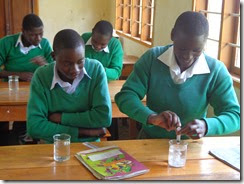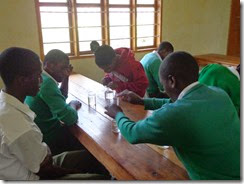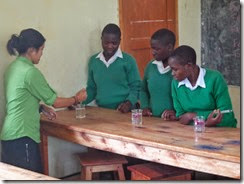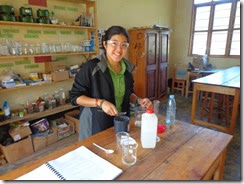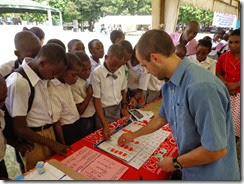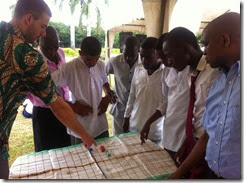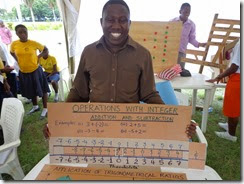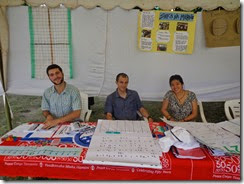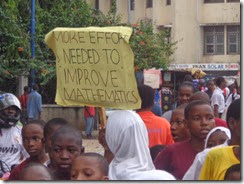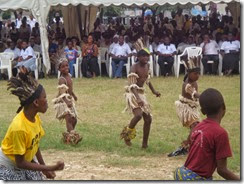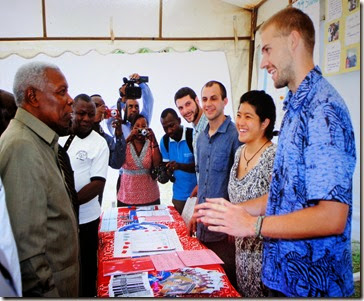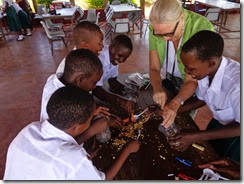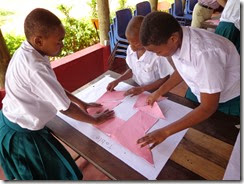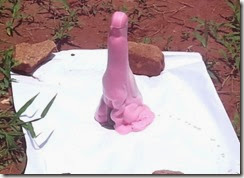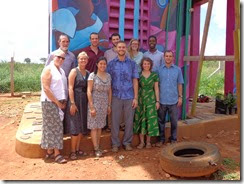For part of my 2-week midterm and Easter break, I returned to Belle’s site in Mbeya. In addition to puzzling and cooking tons of delicious food, we decided it would be a good idea to put on some kind of event for World Malaria Day (April 25th) to help raise awareness at her school. But because we are both huge science nerds, we also wanted to find a way to incorporate math and science into the activities. So Thursday the 24th, we held a special World Malaria Science Day for Belle’s Form IV students.
First of all, we wanted to see what the kids already knew about malaria, so we gave them a short quiz of True/False and short answer questions pertaining to the disease, particularly in Tanzania. (See below to take the quiz yourself!) It turned out they actually knew a lot about malaria, which was great! There is a topic in the Biology syllabus that focuses on HIV/AIDS and malaria, so it was good to see that they had retained a lot of that very important information.
After they finished taking the quiz, we went over the answers and allowed the students to ask any other questions they may have had about malaria. What great questions! It really showed that these were some of the top performing students at their school – they were all very engaged in the conversation and truly wanted to learn as much as they could about malaria!
After finishing the Q and A discussion, we moved on to the first activity. The goal was to show how mosquito nets are useful in preventing the spread of malaria. For this activity, we split the students (and one teacher who wanted to participate as well) into 2 teams. One student from each team held a picture of a person (or gingerbread man, if you’re judging my drawing skills…). The rest of the students formed a line and one-by-one had to grab a colored toothpick, or stiki, run up to the front and try to poke it into the drawn person’s body to emulate getting bitten by a mosquito. It was a kind of relay race, so when they got back to the line, the next student could go. We wanted to see how many toothpicks they could stick on the board in 1 minute.
The trick was, however, that one of the teams had a mosquito net covering their person, which obviously made it more difficult to poke through and reach them. At the end of 1 minute, we looked at the two people and saw that the one not using a net of course had many more mosquito bites than the one protected by the net.
Then, to add a math spin on the activity as well, we said that among the different colored toothpicks (red, blue, green, black, plain), the red toothpicks represented bites from mosquitoes carrying malaria. Given the drawn person who was riddled with mosquito bites of all colors, we asked the students to give the probability of getting bitten by a malaria-carrying mosquito based on the given distribution. From the activity, there were 13 total toothpicks stuck to the person, 3 of which were red. So the students were able to figure out that the probability of being bitten by a mosquito carrying malaria was 3/13. They were very excited to see a useful application of math!
Our next activity was aimed at showing how malaria gets transmitted among humans and mosquitoes. For this activity, we gave each student a beaker of water. The female students were mosquitoes (because only female mosquitoes can carry malaria) and the male students were humans. Belle began as the lone malaria-carrying mosquito, and so her beaker contained a colorless sodium hydroxide solution, which represented the malaria infection. The female mosquitoes were each given a syringe and told to walk around to the different humans and exchange small amounts of liquid from each of their beakers. They had to show two transfers of liquid using the syringes – first, taking some of their own liquid and depositing it into the human’s beaker (to show the passing of saliva from mosquito to human) and then also to take some liquid from the human and place it into their own beaker (to show the sucking of the human’s blood).
This went on for a few minutes until all of the mosquitoes had a chance to bite all of the humans. After that, we had all of the mosquitoes come up to the front of the room. Although all of the beakers remained colorless, we wanted to know which of the beakers were now infected with malaria (sodium hydroxide). Using a special indicator called phenolphthalein (PoP), we could determine which beakers were infected and which weren’t. PoP is an indicator that remains colorless in acidic and neutral solutions (e.g. water), but gives a bright pink color when added to basic solutions (e.g. sodium hydroxide). So by adding a small amount of PoP to each beaker, we knew that if we saw pink, the beaker must be infected with malaria. It turned out that all of the mosquitoes and humans were now infected with malaria, even though we began with only a single malaria-carrying mosquito!!
How could this be? When Belle began biting humans, she was transferring the malaria infection to all of them and causing them to become carriers. Then when another mosquito came along and bit the same person, they contracted the infection and helped to pass it on to other humans. Even the one human that Belle did not bite directly ended up with malaria, because other mosquitoes who had become infected were able to pass it on to him. The activity was a great way to learn about the transmission of malaria, while getting a good Chemistry review at the same time!
Our World Malaria Day event was a great success and a wonderful opportunity to show more of the important everyday applications of math and science. Thanks so much to Belle and Mwatisi Secondary for making it all possible!
I also want to take this chance to thank each and every one of you who donated to my Math and Science Conference project! The grant is now fully funded, and we have begun preparations for our Njombe conference in mid-May. More on that to come soon, but for now, THANK YOU, THANK YOU, THANK YOU!!!
And finally, as promised, here is the malaria quiz so that you can see how much you know about malaria (answers at the end). Karibu (Welcome)!
I. True/False
- Malaria is a major problem in Tanzania.
- Mosquitoes spread malaria by transferring blood to humans.
- Mosquitoes can spread HIV/AIDS.
- If you have malaria, you don’t need to use a bed net.
- Malaria test kits are always correct.
- Only some regions of Tanzania must be concerned with malaria.
- Everyone should sleep with a mosquito net.
- All mosquitoes can transmit malaria.
- Malaria can be passed through pregnancy from mother to child.
- Mosquitoes are more common in cold areas.
- Mosquitoes tend to reproduce in moving water.
- Everyone who is sick has malaria or influenza.
- Malaria can be passed from one person to another like a cold or flu.
- In 2010, 660,000 people died from malaria world-wide.
- Malaria is most common in Africa.
II. List 3 prevention strategies to avoid getting malaria.
III. Why is malaria so common in Africa?
IV. What more would you like to know about malaria?
Answers:
I. True/False
- True
- False – Mosquitoes only transfer saliva to humans, not blood.
- False – Because mosquitoes do not transfer blood to humans, they can not transfer HIV/AIDS.
- False – You can still transfer malaria to other mosquitoes and hence humans, so you should still use a net.
- False – Malaria tests can be wrong! Nothing is 100% accurate.
- False – Malaria is a problem in every region of Tanzania.
- True
- False – Only female Anopheles mosquitoes transmit malaria.
- True – This is called congenital malaria.
- False – Mosquitoes are found mostly in warm and tropical climates.
- False – Mosquitoes tend to reproduce in stagnant water.
- False – This is a common misconception in Tanzania. Many people write off any kind of sickness as either malaria or the flu, which leads to many incorrect diagnoses.
- False – Malaria exists in a human’s bloodstream and thus cannot be transferred by ordinary contact or by coughing, sneezing, etc.
- True – According to the World Health Organization (WHO)
- True
II. Malaria Prevention Strategies
- Sleep with a bed net
- Keep mosquitoes from biting you, especially at night
- Insect repellant and spray
- Wear long-sleeved shirts if out at night
- Wear light colored clothing
- Take malaria prophylaxes/medication
- Kill mosquitoes!!!
III. Why is malaria so common in Africa?
- Tropical climate
- Lack of malaria control programs
- Lack of treatment and medication availability
- Lack of education about malaria prevention
IV. Other questions?
Check out some of these great sites for more info on malaria and World Malaria Day!
World Health Organization (WHO): http://www.who.int/topics/malaria/en/
Centers for Disease Control and Prevention (CDC): http://www.cdc.gov/malaria/
Stomp Out Malaria (Peace Corps Initiative): http://stompoutmalaria.org/
Tanzania-Specific Page: http://stompoutmalaria.org/tanzania/
World Malaria Day 2014: http://www.who.int/campaigns/malaria-day/2014/event/en/
